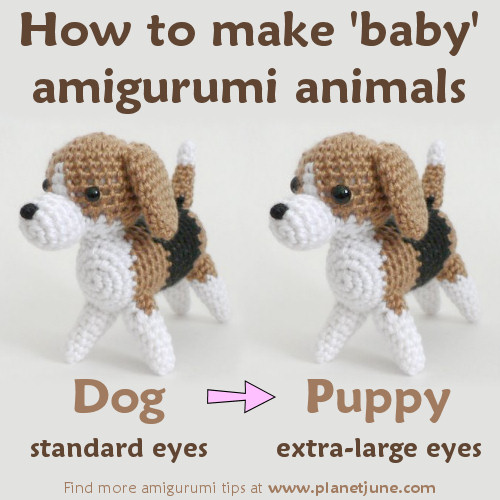With the Baby Animals CAL in full swing in the PlanetJune Ravelry group, I thought I’d demonstrate a couple of simple methods to convert almost* any amigurumi animal pattern into a ‘baby’ with very little effort and no pattern modifications.
Method 1: Use Bigger Eyes
This couldn’t be simpler: to make an individual animal automatically look cuter and more babyish, all you need to do is use proportionally larger eyes than those recommended in the pattern. This works because baby animals (and humans!) are born with very large eyes in proportion to the rest of their bodies.
There are, of course, other differences (larger head, shorter limbs, larger paws, shorter muzzle, etc), but just making this one change can instantly turn an amigurumi dog into a puppy, for example:

Don’t you want a Beagle puppy now?
Method 2: Make a Mother & Baby
The other easy and effective way to make a ‘baby’ amigurumi is to crochet two of the same animal, and make one much larger or smaller than the other. You can do this with no changes at all to the pattern, simply by using a heavier yarn (and correspondingly larger hook) to make a larger adult, or a finer yarn (and correspondingly smaller hook) to make a smaller baby (see my Resizing Amigurumi tutorial for more details).

The blue Elephant is definitely an older sibling to the tiny baby grey ones!

Mama and baby Polar Bears
And here’s a gorgeous example from Amanda from Australia (via my Ravelry group), who made a Tuxedo AmiCat with her own little AmiKitten:

Awww! Amanda’s absolutely adorable AmiCat and kitten
Method 3: Do Both!
You can combine Methods 1 and 2: try using the same size eyes in both sizes of your amigurumi animal, and they’ll look even more realistically like a mama and baby! Just look at my little brown Alpaca and see how cute he looks with his smaller body and relatively big eyes:

Same size eyes in a smaller body: definitely a baby!
*Caveat
I said you can use these tips with almost any amigurumi animal pattern for a reason: these techniques only work for animals where the baby is essentially a miniature version of the adult. Some animals have very different looking young: most obviously, any that go through a metamorphosis (for example, a baby butterfly is a caterpillar, not a tiny butterfly, and a baby frog is a tadpole, not a miniature frog).
This also applies to birds, who turn from a bundle of fluff into a sleek-feathered adult. For example, using bigger eyes or a smaller hook/yarn combo with my (adult) Emperor Penguin pattern would definitely not give you a Baby Emperor Penguin!

Remember, baby birds look nothing like their parents…
Aside from those few exceptions, these simple techniques are the easiest way to make a ‘baby’ animal without needing a whole new pattern. Give it a try and breathe new life into your animal patterns by making cute baby versions of them, or an adorable mama-and-baby pair!
(And, if you’re tempted to give it a go in the next couple of weeks, don’t forget to show off the resulting amigurumi by entering them in the PlanetJune Baby Animals crochet-along on Ravelry!)
Loved this tutorial? I have so many more amigurumi tips and tricks to share with you!
Boost your amigurumi skills with my latest book, The Essential Guide to Amigurumi, your comprehensive guide to amigurumi techniques and tips.
Do you find my tutorials helpful? If so, please consider making a contribution towards my time so I can continue to create clear and concise tutorials for you:
Thank you so much for your support! Now click below for loads more crochet video and photo tutorials (and do let me know what else you’d like me to cover in future tutorials…)


















Mila said
Loved this! Nice and easy tips to make babies. And yes, I get it. Giving a condor big eyes doesn’t make it a condor baby. It just turns it into a condor with really good eye sight. I really love your patterns, and am planning to start crocheting some of them. Plants, flowers, and of course, animals.
I’m an avid embroider, starting to crochet again after a long pause. My favourite embroiderers live in South Africa and Australia. It’s rather difficult to understand that they’re preparing themselves for Autumn, talking about Autumn colours in their work and chilly evenings embroidering/crocheting at the fireplace with a nice cup of tea. Here in Scandinavia, the world explodes in blossoms, flowers, green leaves and grass, the days getting longer and warmer every day.